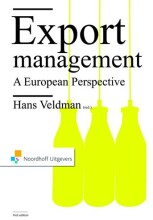Exporting, a structural approach - The Perlmutter theory and the process of internationalization - Motives for leaving the home market
6 important questions on Exporting, a structural approach - The Perlmutter theory and the process of internationalization - Motives for leaving the home market
What two sorts of motives are there to start exporting?
- Pro-active motives
- Reactive motives
Which pro-active motives are there to start exporting?
- Company's objectives and management culture
- Objectives for growth and continuity
- Technological competences/(unique product) suitable for internationalization
- Opportunities in foreign market obtained through market information
- Economies of scale/standardization
- Tax benefits
Which reactive motives are there to start exporting?
- Response to competition
- Home market too small or saturated
- Overproduction/overcapacity
- Incidental, unexpected orders
- Sale of superfluous seasonal products
- Attracting new customers
- Higher grades + faster learning
- Never study anything twice
- 100% sure, 100% understanding
According to Franklin Root, which criteria shoot a multinational meet?
- It has production centres abroad
- It has a differentiated international marketing policy
- Its business strategy in respect of production, marketing, finance and personnel goes beyond national borders
What is a characteristic feature of a multinational according to Root?
Which phases does Root distinguish in the process of internationalization?
- Exporting (partner abroad, expanding foreign sales, production centres moving abroad)
- Manufacturing abroad (sales office abroad, production abroad)
- Own production facilities & independent branches
- Where should most of the sales and production be carried out? (home market or foreign market?)
- Foreign Direct Investment (the company become multinational)
- Global integration (Expansion: acquisitions & mergers)
The question on the page originate from the summary of the following study material:
- A unique study and practice tool
- Never study anything twice again
- Get the grades you hope for
- 100% sure, 100% understanding
































